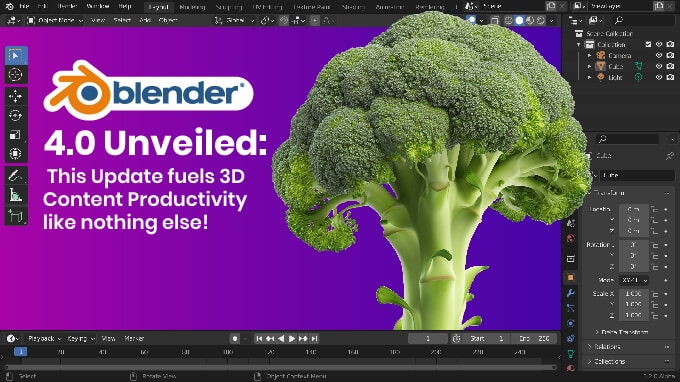Blender 4.0 Unveiled: This Update fuels 3D Content Productivity like nothing else!
- wtsverse
- November 24, 2023
The blender 4.0 version has dawned upon the animation on 14th November and has eminently changed our approach towards 3D animation & artistry. It enhances creativity as well as eases the designers’ woes to a large extent – as a major amount of task minutes are decreased due to these significant changes in the Blender 4 Release.
You can expect key upgrades mentioned below; in the Free and open source blender platform – which can revamp the 3d modeling process to a sizable extent. Combined with its open source DNA & its all-in-one 3d creation pipeline + features – this update is set to become an indispensable tool for 3D artists & metaverse designers.
Renovated UI Font – Inter
You can see a new and innovative form of UI Font called Inter – which is amazing for professional-grade 3D modeling and projects. This font will automatically make it extremely easy for you to work with the blender user interface – as it easy to read rather than the previous font in Blender.
Snapping & Camera Movements
Snapping & camera upgrades may sound like that minor update that Apple does in each new model of its creation – but you will realize its importance only when you use it – just like you only know the apple upgrade’s importance if you own an iphone! While working with the edit mode, you can now hit the B key – and immaculately select a snapping element. Additionally, you can rotate, scale & transform objects with full authority of the camera function – by pressing the Alt Key.
You can actually pick where to snap, effortlessly conduct the edge snapping / vertex snapping process as you wish – which earlier was a major hassle.
Geometry Nodes Tools
One of the most seismic updates in this version is the expansion of Geometry nodes capabilities. Where you once had to drown deep in the C++ or Python technicalities, now the same high level visuals are available with node-based workflows.
Artists can now easily design modifiers tailored to their specific needs – with the geometry node editor. When you can sculpt intricate details and automate modeling tasks to a whole different level – the possibilities are vast.
Geometry nodes editor now helps you to execute an action and create it into a tool – which can directly be applied to another modifier without repeating processes again and again. It opens doors of Blender to a whole new audience – with its “one and done” execution functionality.
The cycles rendering – Majorly requested improvements have been added into this process!
Light Linking is easy as hell – with these updated features. There are expanded light linking workflows which can unlock new artistic possibilities. You can now selectively control which of your project objects are illuminated and which are partially illuminated.
Scene lights can also be set in a way where objects and the nearby surroundings are highlighted in a specific way.
Shadow Linking features has opened new doors for enhanced cinematic experiences – as it now grants granular control over which objects can cast shadows for individual lights. Scenes can also be crafted where realistically you highlight only selected objects – making way for a visual masterpiece.
In the future version, an update to support linking to world lighting is also in the talks, where an artist-friendly user interface helps manage all lights in a scene in one shot!
Before

After

AgX
AgX is the Next-Gen color Management for a filmy preview of many 3D objects. This view transform aims to replace Filmic by providing superior color preservation, especially in overexposed regions. AgX marks a significant upgrade from the existing filmic option.
Composite Node: Kuwahara
The compositor and sequencing toolset expands in the newest blender version – with the debut of the kuwahara node. The kuwahara mode implements an innovative edge-preserving smoothing filter – where you can achieve a full painted look with ease.
This effect intelligently blurs areas while keeping the edges and texture boundaries. Noticeable texture or appearance disturbances are automatically subtracted from the 3D objects.
What a great way to paint any aesthetic onto your projects – with kuwahara mode which opens new doors for many versatile design aesthetics.
Principled BSDF – Major Modeling Updates
Principled BSDF is the do-it-all workhorse in Blender & now has major updates in line for every 3D artist. Micro-fiber sheen model works for materials like cloth, steel and skin – where artists can layer coatings and emission effects. For organic objects, the subsurface scattering also utilizes the base color input for intuitive texturing. You can also scale the RGB radius independently. Glossy reflections and refractions are now governed primarily by the Index of Refraction value for streamlined tuning. Specular tint introduces Fresnel-esque chromatic edges to achieve certain metals and plastics precisely. This is a mere glimpse into the Principled BDSF’s improvements – you can find more details in the Blender’s detailed Documentation.
Whether you design one or a million 3D models – these upgrades will accelerate your productivity and realism in a great way!
Wrapping up,
With numerous enhancements across modeling, animation and rendering, Blender 4.0 Represents the future for open source 3D creation. Whether you appreciate the BSDF updates, compositing or product design updates, this update has something for everyone.
If you find this overview of blender 4.0 interesting, do bookmark our future blogs – until then, Happy Blending!!

